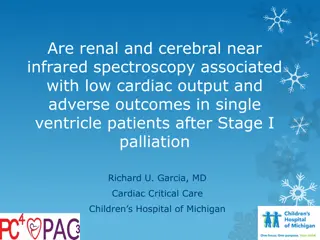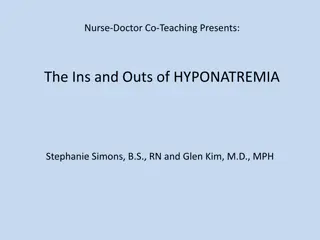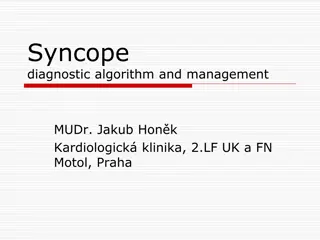Basics of Neuroanesthesia
The intricate mechanisms involved in regulating cerebral blood flow during neuroanesthesia, including factors like pressure autoregulation, metabolic control, and the influence of inhaled agents. Discover the critical interplay between flow and metabolism coupling in maintaining optimal brain perfus
0 views • 44 slides
Understanding Neurogenic Speech and Language Disorders in Adults
This chapter provides insight into language disorders in adults, including types of aphasia, causes such as toxins, traumatic brain injury, brain tumors, and strokes. It discusses cerebral hemorrhage, occlusive strokes, ischemic stroke, transient ischemic attacks, and cerebral thrombosis. The conten
1 views • 34 slides
Explore the Fascinating World of the Brain and its Functions
Delve into the intricate structures and functions of the brain, from its regions to the cerebral lobes. Learn about the roles of the left and right hemispheres, essential sensory and motor areas, and the cerebral nuclei. Discover how the brain enables us to be conscious, control movements, and proce
4 views • 27 slides
Understanding Neuropsychological Assessment: Insights and Applications
Neuropsychological assessment plays a vital role in understanding brain-behavior relationships. This process involves determining cerebral functioning, identifying dysfunction, and assessing cognitive abilities through a combination of interviews, observational data, and testing. The assessment aids
3 views • 33 slides
Understanding Basic CT Perfusion Terms in Stroke Imaging
This educational content delves into fundamental concepts related to CT perfusion imaging in stroke evaluation. It covers key terms such as core infarct, penumbra, Time to Peak, Mean Transit Time, Cerebral Blood Volume, and more. The information includes definitions, descriptions, and the significan
6 views • 16 slides
Airway Management in Neurological Patients: ENLS Version 5.0
Explore the essentials of airway, ventilation, and sedation in neurological patients through the ENLS Version 5.0 content. Understand the challenges and goals of managing airways in critical situations such as trauma or respiratory distress. Learn about common indications for intubation and the impo
0 views • 37 slides
Explore the Structures and Functions of the Brain
Delve into the intricate world of the brain, learning about important structures like the hypothalamus and cerebral cortex. Discover how electrical impulses move through neurons and understand the dual nature of nervous impulses. Engage in activities to map brain functions and test your knowledge wi
1 views • 23 slides
Understanding the Blood Supply of the Brain
The brain receives its blood supply from four major arteries - two vertebral arteries and two internal carotid arteries. The vertebral arteries branch into the basilar artery, which gives rise to various important branches. The internal carotid arteries supply the anterior and middle cerebral arteri
1 views • 30 slides
Comprehensive Overview of Inland Regional Center Services
Providing services to over 35,500 individuals, Inland Regional Center focuses on inclusion, independence, and empowerment. The center plays a crucial role in serving individuals with intellectual disabilities, cerebral palsy, epilepsy, and autism, offering a range of services from early childhood to
0 views • 12 slides
Understanding Ergotherapy in Cerebral Palsy Rehabilitation
Explore the role of ergotherapy in the rehabilitation of children with cerebral palsy, emphasizing the importance of early habilitation, continuous learning, and support strategies for individuals and families. Discover the challenges faced by parents and caregivers, the necessity for acceptance, an
2 views • 15 slides
Association of Renal and Cerebral Near-Infrared Spectroscopy with Adverse Outcomes in Single Ventricle Patients after Stage I Palliation
Study investigates the association between renal and cerebral near-infrared spectroscopy (NIRS) values and low cardiac output syndrome in single ventricle patients post Stage I palliation. Data from infants who underwent surgery between 2010-2019 is analyzed to determine correlations with adverse ou
1 views • 13 slides
Understanding the Meninges, Ventricles, and CSF in the Central Nervous System
The lecture covers the cerebral and spinal meninges, emphasizing the dura, arachnoid, and pia mater layers. It explores the significance of the subarachnoid space and the ventricular system in the CNS, including CSF formation, circulation, and clinical implications.
0 views • 18 slides
Understanding the Olfactory and Gustatory Systems
The olfactory sensory system is unique with direct relay to the cerebral cortex, ipsilateral representation, and the ability for regeneration. It is crucial for our sense of smell and emotional responses to odors. The gustatory area, responsible for taste perception, is closely related to the insula
0 views • 9 slides
Exploring Influences on Consciousness Through Neocortical Interactions
Delve into the intriguing realm of consciousness with Lester Ingber's research on the influences stemming from multiple scales of neocortical interactions. The investigations cover various aspects such as mind over matter, recursive interactions, neuronal scales in the neocortex, and statistical mec
1 views • 41 slides
Understanding the Structure and Function of the Cerebrum
Dive into the intricate details of the cerebrum, the largest part of the forebrain. Explore its parts including the cortex, medulla, basal ganglia, and lateral ventricle. Learn about the lobes, important sulci, and gyri. Understand the types of fibers in the cerebral medulla and their functions. Unr
1 views • 20 slides
Brain Oxygen Optimization in Severe TBI - Protocol Summary
In the severe traumatic brain injury (TBI) protocol, intracranial monitors measuring ICP and PbtO2 are placed within 12 hours of injury. Procedures include FiO2 challenges to check PbtO2 reliability and assess cerebral physiology. Challenges involving FiO2, MAP, and CO2 help guide ventilator setting
2 views • 27 slides
Unlocking the Power of the Human Brain: Insights from 11th ICPAR Annual Training Conference
Delve into the intricacies of the human brain at the upcoming 11th ICPAR Annual Training Conference themed around "Brain Power to Embrace Change and Emotional Stability." Explore the control center of our minds, the cerebral cortex, the limbic system, and the role of neurons in conscious mental reac
0 views • 57 slides
Understanding Proprioception Pathways in Physiology
This information delves into the intricate pathways of proprioception, focusing on the somatotopic organization of ascending sensory pathways, types of receptors involved, dorsal column tracts like gracilus and cuneatus, spinocerebellar tracts, and the role of the cerebral cortex in perceiving propr
0 views • 22 slides
Understanding Cerebral Edema: Causes, Treatments, and Pathophysiology
Cerebral edema is a life-threatening condition that can result from various factors such as trauma, infarction, hemorrhages, or tumors. This condition can lead to increased morbidity and mortality due to hemorrhage or herniation. New advances in understanding the pathophysiology of cerebral edema ha
1 views • 28 slides
Understanding Cerebral Palsy: Causes, Risk Factors, and Pathology
Cerebral Palsy (CP) is a clinical syndrome characterized by motor dysfunction and non-progressive brain damage affecting an immature developing brain. This article explores the definition, risk factors during prenatal, natal, and postnatal periods, and the pathology associated with CP, including dif
1 views • 38 slides
Understanding Hyponatremia: Clinical Presentation and Management
Nurse-Doctor Co-Teaching presents a case study of a 63-year-old woman with hyponatremia, discussing key observations and factors relevant to her condition. The session aims to simplify the complexities of hyponatremia by reviewing the importance of correction rates, providing a framework for patient
0 views • 15 slides
Diagnosis Criteria for Perinatal Asphyxia
Perinatal asphyxia refers to the interruption of oxygen supply to the fetus or newborn, leading to metabolic consequences and potential multiorgan dysfunction and long-term neurological issues. The American Academy of Pediatrics (AAP) and the American College of Obstetrics and Gynecology (ACOG) have
0 views • 12 slides
Association of Renal and Cerebral Near Infrared Spectroscopy with Low Cardiac Output in Single Ventricle Patients
Near-infrared spectroscopy (NIRS) has been studied in infants after Stage I palliation surgery to assess its association with low cardiac output and adverse outcomes. This retrospective study investigated postoperative cerebral and renal NIRS values in infants with single ventricle physiology. Resul
0 views • 13 slides
Buy AK Diesel Online - globaldrugsstore.com
Buy AK Diesel Online is a unique hybrid that combines the powerful genetics of AK-47 and Sour Diesel. This blend results in a strain that offers a potent mix of uplifting cerebral effects and relaxing body sensations. Imagine the perfect blend of a
1 views • 3 slides
Center for Studying Disability Policy Compendium: Data Collection Methods
This compendium provides a comprehensive overview of collecting data on people with disabilities, featuring 554 indexed references since 2012. It aims to fill knowledge gaps, serving as an up-to-date and accessible resource released annually. The development process involves obtaining diverse refere
0 views • 11 slides
Treatment Strategies for Hemorrhagic Stroke: Goals and Management
Short-term goals for treating hemorrhagic stroke involve rapid neurointensive care to maintain adequate oxygenation, breathing, and circulation, along with managing increased intracranial pressure and blood pressure. Long-term management focuses on preventing complications, recurrent bleeding, delay
11 views • 9 slides
Confusion and Stroke: A Challenging Case Presentation in the Emergency Department
A patient with a history of cerebral aneurysm presented to the Emergency Department with confusion and hiccups. Despite initial stability, imaging revealed findings suggestive of a possible stroke. Further studies including cEEG and lumbar puncture were performed. The MRI findings indicated restrict
0 views • 11 slides
Lumbar Puncture: Procedure, Complications, and Clinical Applications
Lumbar puncture, also known as LP, is an invasive procedure used to obtain cerebrospinal fluid (CSF) for diagnostic and therapeutic purposes. This procedure has a long history dating back to ancient times, with modern techniques developed in the late 19th century by Heinrich Quincke. LP is crucial f
2 views • 11 slides
Understanding Akabane Disease: Causes, Symptoms, and Prevention
Akabane disease, also known as Enzootic Bovine Arthrogryposis and Hydranencephaly, is a viral illness transmitted by arthropods that primarily affects calves, lambs, and kids. The disease can lead to congenital abnormalities such as joint immobility and absence of the cerebral hemisphere. It is caus
2 views • 19 slides
Syncope: Diagnostic Algorithm and Management Overview
Syncope is defined as a transient loss of consciousness due to cerebral hypoperfusion, with rapid onset and complete recovery. It poses risks of falls, trauma, and sudden death but is mostly benign in young individuals. Initial evaluation includes a thorough history, physical exam, and ECG. Classifi
0 views • 18 slides
Investigating HIF-1 and Apold-1 in Endothelial Permeability at the Blood-Brain Barrier
Understanding endothelial permeability at the blood-brain barrier is crucial for drug delivery to the brain. This research aims to identify a potential mechanism between HIF-1 and Apold-1 specific to cerebral epithelial cells that may impact the integrity of the blood-brain barrier. The study involv
0 views • 14 slides
Comprehensive Management of Head Injury: Overview and Key Strategies
Head injuries pose a significant threat to morbidity and mortality, with causes ranging from motor accidents to child abuse and falls. Understanding the epidemiology and pathophysiology of head injuries is crucial for effective management. Primary and secondary brain injuries necessitate immediate c
0 views • 42 slides
Understanding Hypertensive Disorders of Pregnancy
Hypertensive disorders of pregnancy encompass conditions like pregnancy-induced hypertension, chronic hypertension, pre-eclampsia, eclampsia, and imminent eclampsia. Pre-eclampsia, affecting around 3% of pregnancies, poses risks such as elevated BP, fluid retention, and various clinical manifestatio
0 views • 27 slides
Ankle Fracture in a Patient with Cerebral Palsy: Diagnostic Radiology Case Study
A 57-year-old male with a history of cerebral palsy presented with ankle pain following a ground level fall. Examination revealed a Danis-Weber type B3 fracture subluxation and a displaced age-indeterminant fracture of the talar neck with midfoot collapse. Key imaging findings included soft tissue s
0 views • 15 slides
Understanding Neuroglia: The Connective Tissue of the Nervous System
Neuroglia, a vital component of the nervous system, play a crucial role in providing support, protection, and defense to neural tissue. Recent research has highlighted their involvement in various disorders, including autism spectrum disorders (ASD). This article explores the functions and contribut
1 views • 21 slides
Understanding Antiemetic Screening Models in Pharmaceutical Science
Explore the fascinating world of antiemetic screening models in pharmaceutical science, covering topics such as the pathogenesis of vomiting, choice of emetogens, commonly used animals, parameters assessed, screening models, and more. Learn about drug-induced emesis models and the critical parameter
0 views • 25 slides
Expert Guidelines on Treatment of Small Vessel Disease
Expert recommendations for the management of covert cerebral small vessel disease (ccSVD) emphasize the use of antihypertensive treatment for hypertensive patients to prevent SVD lesion progression. While there is limited evidence supporting intensive blood pressure lowering targets, systematic bloo
0 views • 14 slides
Understanding Haemorrhage and Its Impact in Surgery
Haemorrhage in surgery is a critical phenomenon leading to hypovolaemic shock, trauma-induced coagulopathy, and other complications. It involves ongoing bleeding, hypoperfusion, acidosis, and hypothermia, exacerbating the condition. Classification includes revealed and concealed haemorrhage, with pr
0 views • 33 slides
Understanding Shock: Types, Classification, and Clinical Course
Shock is a critical state where the circulatory system fails to adequately perfuse cells, leading to oxygen and nutrient delivery reduction. It can be classified into hypovolemic, cardiogenic, and distributive types, with septic shock caused by microbial infections. Shock progresses through stages f
0 views • 8 slides
Assistive Communication System for Individuals with Cerebral Palsy Using Head Movement and Speech Recognition
Development of a multimodal communication aid system for individuals with cerebral palsy, addressing challenges such as dysarthria and involuntary movements. The system allows users to communicate through head movements and speech recognition, reducing the reliance on caregivers and minimizing disru
0 views • 15 slides







































